Red Rackham's Treasure (French:
Le Trésor de Rackham le Rouge)
Original publication dates: February 1943 – September 1943
First collected edition: 1944
Author: Hergé
Tintin visits: Belgium (Brussels, Antwerp, Marlinspike), Caribbean Sea (unidentified island).
Overall rating:





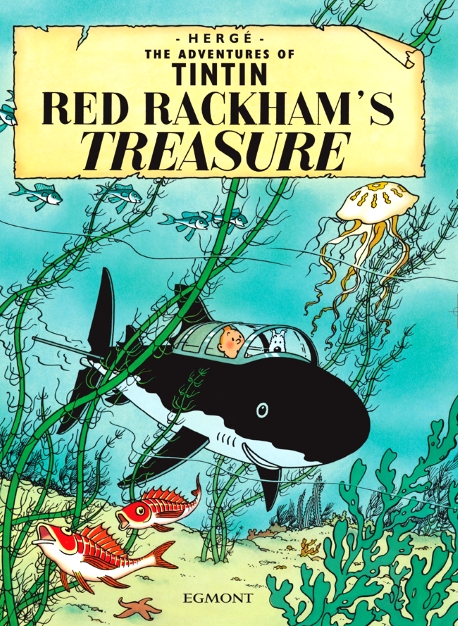 Plot summary available here
Plot summary available here.
Publisher's synopsis:
Tintin, Snowy and Captain Haddock set off to find the long-lost treasure of Red Rackham the pirate. From their discoveries in The Secret of the Unicorn, they possess the vital clue to the treasure's hiding-place. But this is no easy search, particularly when the detectives Thomson and Thompson, and Professor Calculus, are in the party. After strange finds on a desert island, and hazardous underwater adventures, the treasure-hunt has an unexpected ending.Comments:
Red Rackham's Treasure continues and completes the story begun in the previous Tintin book,
The Secret of the Unicorn. The story was originally published in serial form in the pages of the popular Belgian French-language newspaper,
Le Soir, between February and September 1943, with the adventure later being collected into the standard 62-page album format in 1944. Like its predecessor, the adventure was written and published during the German occupation of Belgium during World War II. As a result, Hergé produced a work of pure escapist fantasy, devoid of the political themes that had often coloured his earlier work, and which would've undoubtedly landed him in trouble with the occupying Nazi regime.
Interestingly, there's no central villain or antagonist in
Red Rackham's Treasure. It's really just a tale about the exploits that befall Tintin and his friends, as they prepare for, and then undertake, a voyage to an uncharted, exotic island in search of the pirate Red Rackham's booty. Despite this lack of an adversary, the book succeeds as a gripping adventure tale because Hergé is utterly in love this pseudo-
Treasure Island setting, with its eerie shipwrecks, buried treasure, and talking parrots. The author's enthusiasm for the far flung Caribbean locale and the search for sunken treasure is apparent in virtually every panel.
Before I get any further into discussing the book, let me first talk about that front cover. Now that's an image that jumps out from the book store shelves! With its aquatic colours, exciting underwater setting, and exotic marine life, the image of Tintin and Snowy exploring the sea floor in a shark-shaped submarine is simply fantastic. Is there a more striking cover in the whole Tintin series? Not as far as I'm concerned! The yellowed, curling parchment, onto which the title is set, only adds to the effect, ensuring that this is a cover which screams "adventure awaits!"
Perhaps the most significant aspect of
Red Rackham's Treasure, when viewing it in the context of the Tintin series as a whole, is the addition of Professor Cuthbert Calculus to the cast...
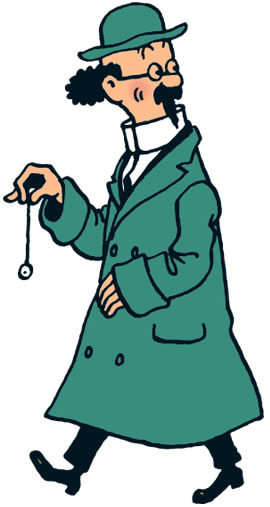
Hergé had experimented with a number of different eccentric or absent-minded professors in some of his previous Tintin books, such as Sophocles Sarcophagus in
Cigars of the Pharaoh, Professor Alembick in
King Ottokar's Sceptre, and Professor Phostle in
The Shooting Star. But with the introduction of Professor Calculus, he finally hit upon an elderly academic that he was satisfied with. Finally, after 15 years of adventures, the principal cast of The Adventures of Tintin was complete.
Calculus was originally named Tryphon Tournesol in the French edition of the book, and Wikipedia informs me that the word "Tournesol" is French for sunflower. The eccentric physicist's defining character trait is his extreme deafness – which he himself refuses to acknowledge, claiming instead to be just "a little hard of hearing". This inability to hear results in amusing conversational misunderstandings a-plenty, as seen in the good professor's first appearance...
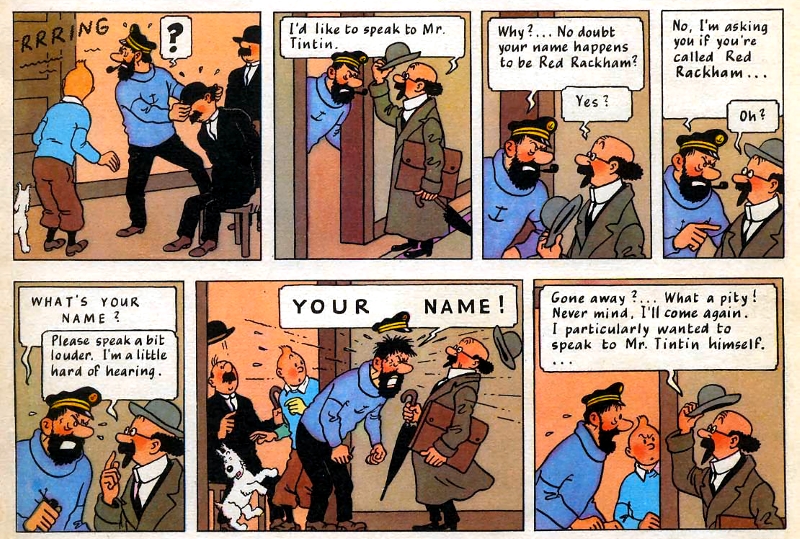
By the way, I love the fury that Hergé draws into the penultimate panel above, as Captain Haddock's exasperation and annoyance with Calculus reaches breaking point.

It's a testament to Hergé's skills as a writer that Calculus's deafness never once becomes annoying – something that could've easily happened in the hands of a lesser writer, and which could've ruined the book. Instead, the professor's comedic potential is expertly rationed by the author and, as a result, it provides plenty of genuine chuckles.
Aside from functioning as comic relief, Calculus also invents many useful technological devices in the series, such as the shark-shaped submarine depicted on the book's cover. This is arguably the most memorable of all Calculus's inventions, with the submersible's shark-like appearance designed to provide camouflage and protection to Tintin and his friends from the real life sharks that they may encounter in the Caribbean Sea. Though they initially protest against taking the contraption with them, the professor is absolutely right, and Tintin and Haddock do indeed encounter sharks as they search for the shipwreck of the
Unicorn.
Aside from Calculus's auditorily-challenged comedy, there are plenty of other amusing moments in
Red Rackham's Treasure. A lot of the humour comes from the fact that there is an abundance of slapstick in the book – way more than there was in
The Secret of the Unicorn. Take this eye-roll inducing gag, involving Haddock, a pillar, and the wry usage of an advertising slogan...
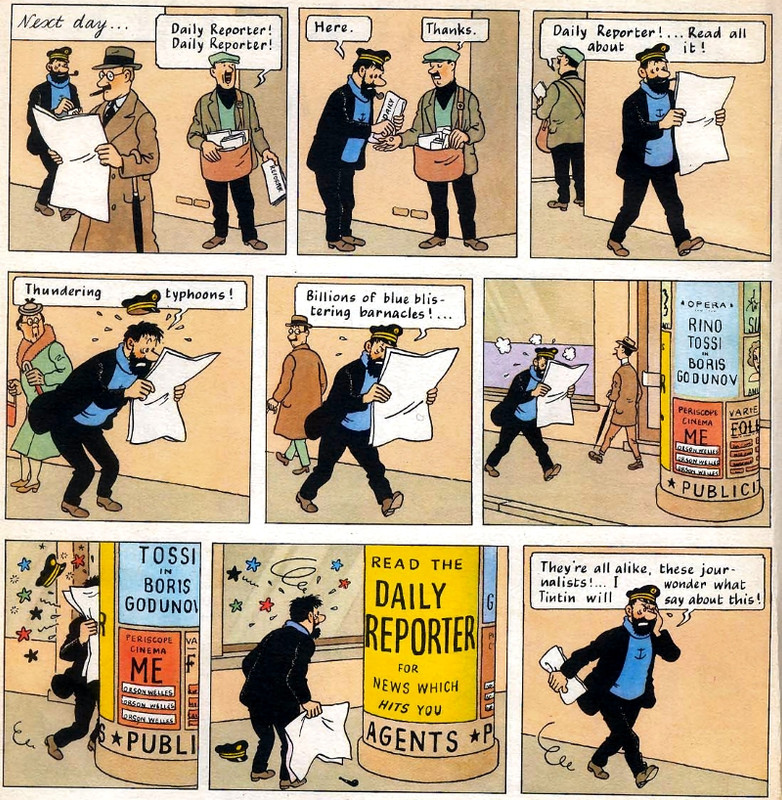
On occasion, the humour is a little dated, however, such as with the rather unfortunate depiction of a man of African extraction, seen among the chancers and con men lining up to claim lineal descent from Red Rackham and a share of the treasure...
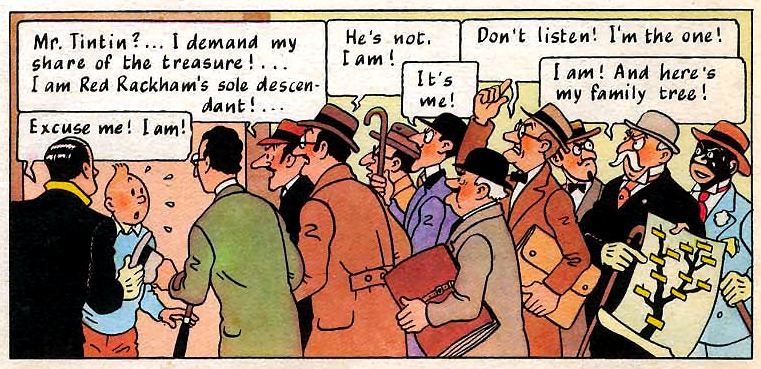
The joke being, of course, that this dark-skinned African gentleman couldn't possibly be a descendant of the French pirate Red Rackham. To be honest, if we put aside our 21st century mores and the offensive nature of the caricature, this is actually a pretty funny visual gag.
Something else I want to make note of is that, during the search for the mysterious Caribbean island, Haddock tells Tintin that sometimes small, unimportant islands aren't always marked on navigational charts. In this day and age of GPS satellite navigation the idea that there might still be uncharted islands in the world seems rather quaint. A relic of a time gone by. But let's face it, we all love the idea of finding a small, half-forgotten corner of the world to explore, don't we? And Hergé is no different.
Red Rackham's Treasure is the author's paean to exploration – a theme that would resurface again in
Destination Moon and
Explorers on the Moon.
I think the artwork in the book is some of Hergé's best so far in the
ligne claire style. In particular, I love this panoramic view of the mysterious island...
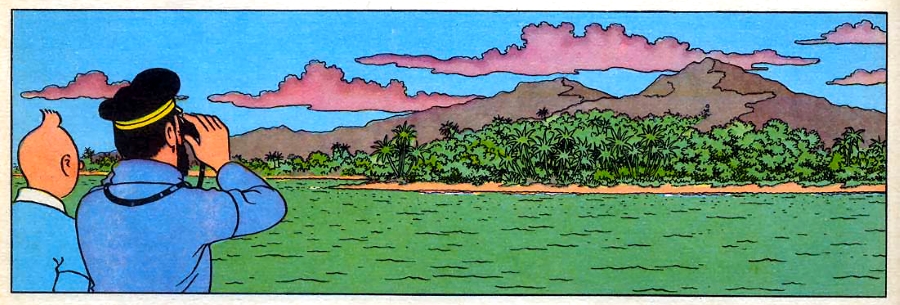
This deceptively simple panel is the full width of a page, which allows the reader to examine and explore the island that Tintin and his friends are about to investigate by eye, just as the characters do. With its cinematic use of perspective, the panel subliminally draws the reader deeper into the story, ratcheting up the tension. Hergé almost draws movement into this panel too, with the sea seeming to gently ebb, as white clouds scud above the island.
Later, the artist gives us some glorious depictions of the lush jungle that covers much of the tiny isle...
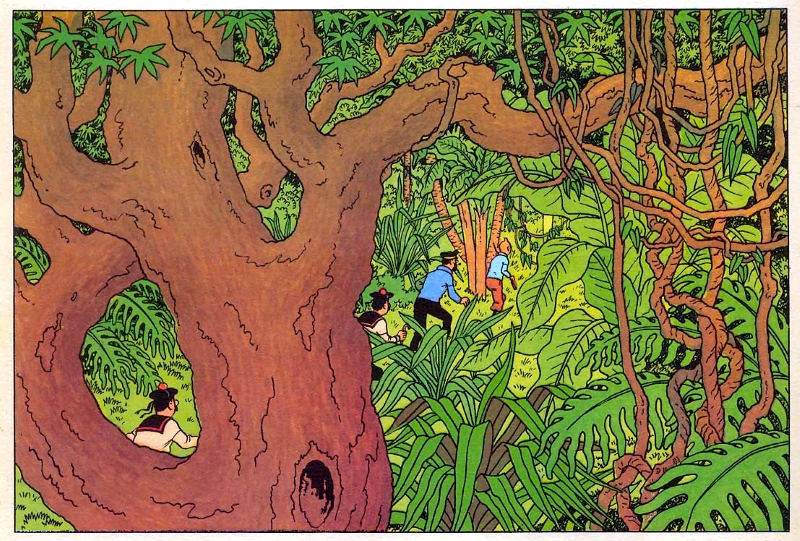
Hergé himself was always very proud of the panel below...
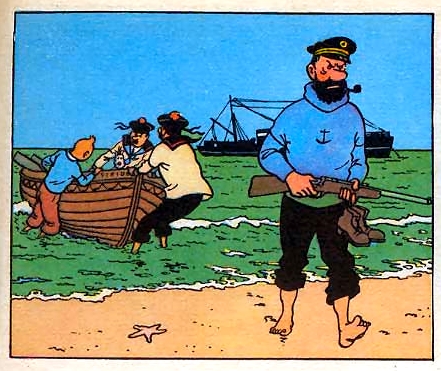
In interviews, the artist commented that he thought it a particularly well done frame. It represents three key elements within the narrative: a) the horizon and the fishing trawler
Sirius anchored off-shore in the background; b) Tintin and the Thom(p)son Twins pulling the rowing boat onto the beach in the middleground; and c) Haddock walking onto the sand in the foreground, as the exploration of the island begins. In this way, Hergé blends three different story events into a single small square.
Perhaps even more striking than Hergé's depictions of the island are the book's wonderfully atmospheric underwater scenes. In particular, this panel showing Tintin in a old-fashioned diving suit, approaching the majestic wreck of the
Unicorn for the first time, is superb...
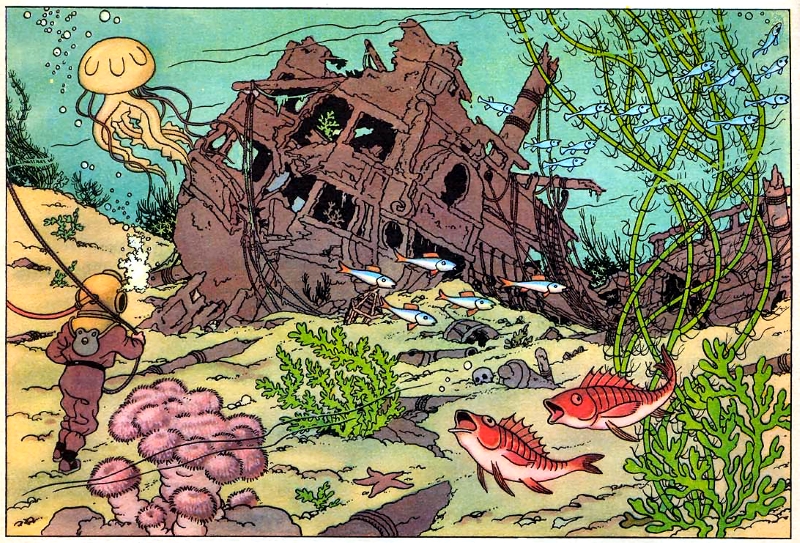
It really is hard to find much fault with
Red Rackham's Treasure, but one tiny aspect of the story that has always slightly annoyed me, is that, while on the island, our heroes discover talking parrots who use "Captain Haddock-esque" insults handed down from Sir Francis Haddock, who spent time shipwrecked there. For me, the idea that parrots indigenous to this remote Caribbean island would still talk like Haddock's ancestor, some 300 years later – let alone that the colourful obscenities which Haddock uses would've been handed down from generation to generation by his ancestors – is highly improbable.
Ultimately, despite an intensive search of the island and nearby seabed, Tintin and Haddock are unable to locate Red Rackham's lost treasure. Upon returning to Belgium, Calculus deciphers some old documents found in the wreck of the
Unicorn and deduces that Sir Francis Haddock had once been the owner of Marlinspike Hall (which we first saw in
The Secret of the Unicorn). Calculus buys the country estate, with money he receives from the sale of his submarine design, and generously gives it to the Captain, which is a nice twist, considering all the annoyance that the professor has caused Haddock.
Upon searching the château's cellars, Tintin and the Captain discover that the treasure is hidden there, making them both wealthy beyond their wildest dreams. By enacting this dramatic shift in the series' status quo, Hergé transforms Tintin and Haddock into men of leisure. They will no longer need to worry about jobs or wages, which leaves them free to travel the globe as any given adventure may require.
Overall,
Red Rackham's Treasure is a really fun story, with a delightfully whimsical feel to it. This was Hergé's affectionate homage to those old-fashioned tales of globe-trotting daring-do that so enthralled him as a child. Like
The Secret of the Unicorn, the book finds Hergé firing on all cylinders creatively and, in fact,
Red Rackham's Treasure might be even better than the first part of the adventure. It's hard to choose between the two though, especially since they are parts of the same whole. Regardless of which is the best, I'd say that this two-part adventure is an ideal starting point for a newcomer to The Adventures of Tintin.